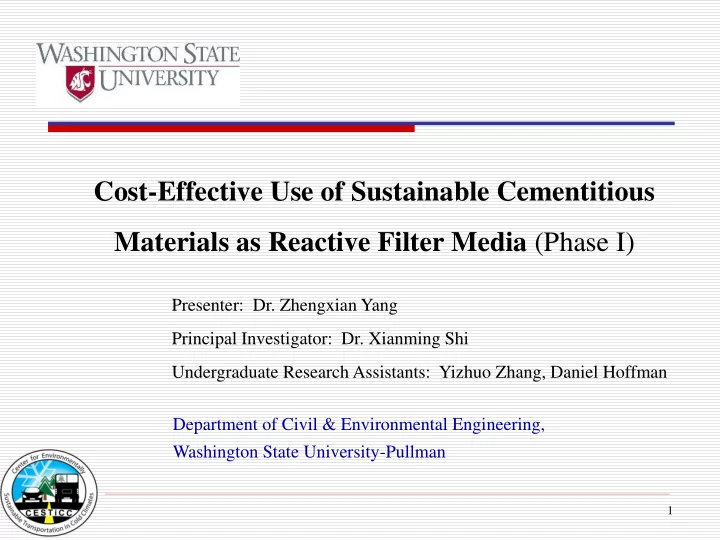

Cost-Effective Use of Sustainable Cementitious Materials as Reactive Filter Media (Phase I) Presenter: Dr. Zhengxian Yang Principal Investigator: Dr. Xianming Shi Undergraduate Research Assistants: Yizhuo Zhang, Daniel Hoffman Department of Civil & Environmental Engineering, Washington State University-Pullman 1
Background-chloride pollution Chloride pollution due to deicer use is a significant source of water quality impairment. 1) Chloride is highly soluble, non-degradable, difficult to remove, and tend to accumulate over time. 2) Chloride can form complexes with heavy metals, rendering many of them more water soluble and therefore exaggerate heavy metal and other biota relevant contamination to soils, vegetation, wildlife and aquatic species http://eastmetrowater.areavoices.com/ http://ceds.org/aquatic.html 2
Background-chloride pollution Current standards used by (US EPA) for chloride in surface waters are 230 mg/L maximum chronic exposure for a four-day average concentration of dissolved chloride associated with sodium, and 860 mg/L maximum acute exposure for a one-hour average concentration, occurring no more than once every three years on the average [US EPA 440/5-88-001]. When chloride concentrations in streams reach or exceed the acute and chronic standards, toxicity to aquatic species can result. https://www.cityofmadison.com https://www.pinterest.com/ 3
Background-concrete demolition waste Construction and demolition (C&D) waste is the largest single source of all generated municipal solid waste. In the US, the remaining landfill capacity has almost reached to its upper limit for disposal of these large amounts of waste. EPA data: in 2013, 335M Tons concrete demolition waste was generated in the US, of which about 10% (estimated) fine fractions can’t be recycled for new construction and are significantly under - utilized . http://crushconqld.com.au/ http://www.sonomacountywaste.com 4
Project Objectives Evaluate the effectiveness of crushed fines from recycled concrete (CFRCs) followed by nano-modified cement paste powder (NMCPP) as reactive filter media to treat synthetic waste water with high levels of chlorides and typical levels of total P, total nitrogen and metals; Unravel the mechanisms underlying contaminant removal by these engineered sorbents. Kill Two Birds with One Stone! 5
Work That has been done 6
Collecting Old Concrete The old concrete was collected from demolition. The construction site is located on campus of Washington State University-Pullman. 7
Crushed Fines from Recycled Concrete (CFRCs) CFRCs was obtained by crushing the old concrete. 8
Nano-modified cement paste powder(NMCPP) NMCPP was prepared by crushing the laboratory fabricated cement paste samples. 9
Materials to Make NMCPP 10
Chloride and cement content in CFRCs The chloride and cement content in CFRCs were measured by using Volhard titration and nitric acid boiling methods respectively. The amount of chloride contamination in the old concrete is 0.04% by weight of CFRCs. The cement content in CFRCs is 31% by weight of CFRCs. 11
Characterization of CFRCs The specific surface area of the finest powder of CFRCs determined by BET surface area analyzer is 10.64 m 2 /g. CFRCs samples have also been sent to XRD, XRF and FTIR for chemical composition analysis. But the results are still not available. The chemistry and surface morphology will also be investigated by SEM/EDS. Relevant characterization for NMCPP are undergoing. 12
Next Step--- Work Anticipated in the Upcoming Quarters 13
Synthetic Stormwater Solutions Two synthetic stormwater solutions (interested to highway agencies) will be made using tap water and commercially available chemicals, to simulate two typical high levels of chloride loading, and a typical loading of total P, total nitrogen and metals (e.g., Cu, Pb and Zn) 14
Stormwater Synthesis Chemicals have been collected. 15
Dynamic flow column experiments to assess the removal effectiveness of contaminants 16
Materials for Dynamic flow column experiments PVC pipes Peristaltic pumps Acidic Gravel 4 cm in diameter Motor voltage: 12VDC Water filtered 15cm in length. Flow rate: 2-5ml/min pH: ~6.5 17
Experimental plan: Task 1: Contaminants removal from synthetic stormwater One pore volume DI water to flush through the columns to remove loose particles. Flow rate will be adjusted periodically to ensure steady flow through the experiment and to control retention time Water samples collection 1. For the first 8 hours, the water samples will be collected every 2 hours; 2. Then once every two days until a contaminant breakthrough point occurs; 3. After that, water samples will be collected every 3 hours for 12 hours 4. Dissolved oxygen (DO) in influent and effluent will be checked daily to ensure at a relatively low level Dynamic flow column setup 18
Experimental plan: Task 1: Contaminants removal from synthetic stormwater Water samples analysis 1. pH value 2. Chloride concentration 3. Heavy metal: Cu, Zn, Pb 4. Metal ions 5. Total P 6. Total N 7. Total C and TOC After column test 1. Porosity test 2. Precipitates formed in the remaining solid will be analyzed by XRD and SEM/EDS 19
Experimental plan: Task 2: Mechanistic studies This task will employ advanced tools to shed light on the fundamental mechanisms of contaminant removal by reactive filter media (CFRCs and NMCPP) Each filter media (solid sample) before and after the dynamic flow column experiments will be analyzed by using XRF, XRD, FTIR, and SEM/EDS. Information on overall chemical elements, crystalline phases, and localized morphology and elemental distributions will be obtained through these analysis. 20
Timeline Task 1: Contaminant removal from synthetic stormwater will be finished in October. Task 2: Mechanistic studies will start from August and end in November. Project will be completed in December 2016.
Outcomes and outreach A final report will be submitted to CESTiCC At least one journal paper A patent related to the innovative technology based on this research Seek funding for the follow-up phase for this project, and further promote the use of this type of innovative and cost-effective materials for the management of chloride-laden stormwater Phase II project will be developed with a focus on addressing the recyclability challenge related to contaminant-saturated filter media, thus minimizing the risk of secondary pollution.
Recommend
More recommend